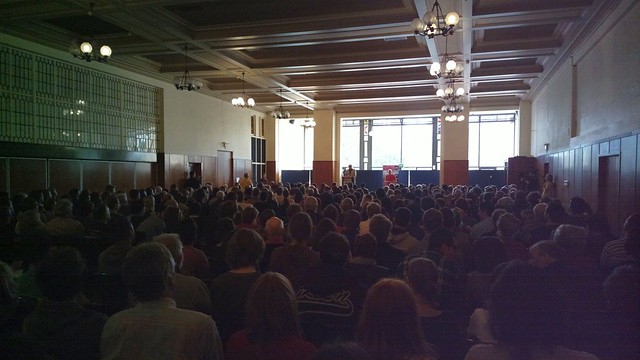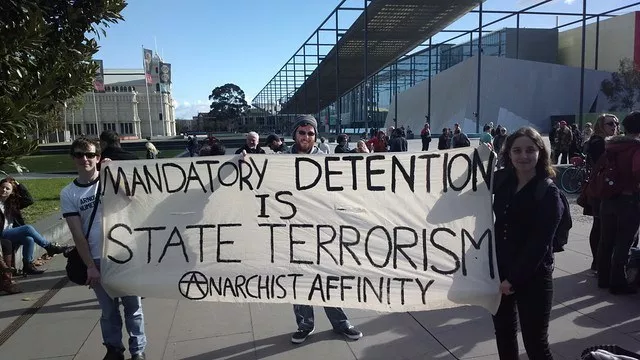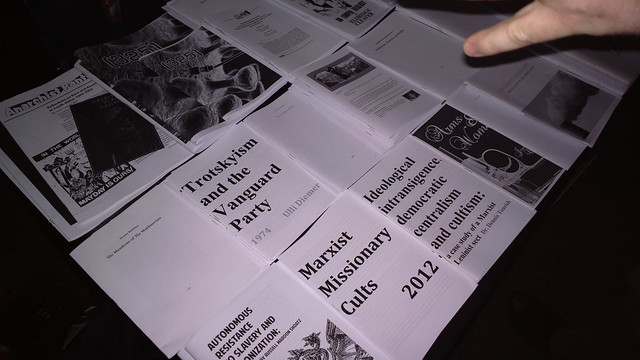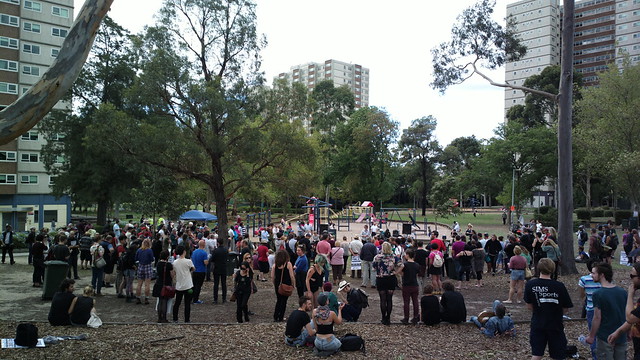Part three in a five part series reviewing Marxism 2013, ‘Sessions other than Anarchism vs Marxism’
The constant tension between debate and recruitment ultimately hindered the extent of discussion that occurred within sessions at Marxism 2013, making the conference into a tedious defence Socialist Alternative.[i]
One of the most topical issues on the far-left is that of 457 Visas.[ii]
Rival International Socialist Tendency group Solidarity leafleted the main stairs entrance in the break before the 457 Visa session, emphasising their differences with Socialist Alternative: up-front working with 457 Visa workers and organising them, challenging racism in the unions.
In the session, Socialist Alternative focused on the racism of the Labor government and distanced themselves from strident critiques of the union movement in propelling Labor’s ‘457 rorts’ campaign, putting to the forefront the explicit rejection of the 457 Visas ‘guest labour’ scheme as undermining working conditions, but organising 457 Visa workers when in Australia.
The session was the debate that was not, which I felt was a real disappointment. Of the hour and half , only about 2 minutes was spent with an opposing argument to the line of Socialist Alternative, also supported by members of Socialist Alliance.
Of the 13 speakers—forgetting about the presentation and conclusion both made by Socialist Alternative— two purportedly were from Solidarity, but one picked was not an active Solidarity member.[iii]
In the Introduction to Marxism stream there seemed to be an unspoken rule to not call rival tendencies, including Socialist Alliance, avoiding discussing political differences. These sessions are the wombs that develop contacts into Socialist Alternative babies.
A session ‘Women, work and family in the neoliberal age’ displayed the worst of the ‘left unity’ process. The Socialist Alternative presentation was firmly backed up by Socialist Alliance speakers.
In the entire discussion, feminism was mentioned twice, patriarchy completely absent.
‘Left unity’ has become a recipe for public lowest common denominator politics, where the most rudimentary point of agreement is elevated to the heavens of dogma for organisations in ‘unity’ discussions. Here it was the necessity to abolish capitalism through a working class revolution.
The conference was crying out for a real discussion and debate on the most controversial position Socialist Alternative took last year.
One speaker threw mid-sentence that the elephant in the room was ‘sexual violence’, a veiled reference to the striking disagreement between Socialist Alternative and Socialist Alliance on Reclaim the Night.[iv]
That said the presenter did not reduce women’s oppression down just to material conditions but also discussed its ideological basis. Some of the discussion from contributors was fruitful in prioritising the practical ways, for example, partners can challenge sexism, such as through equal childcare.
Despite the conference being organised by one organisation with a clear platform, the marketing onus to invite drawcard speakers fleetingly broke the monotony—allowing ambiguity and different politics.
In presenting his distinctive Gumbainggir take on Aboriginal resistance in Australia, Gary Foley’s good-humoured talk was the only session where an anarchist presented.
In the biggest session of the conference, radical journalist John Pilger emphasised the dangers of reliance on social media; its atomisation of people and centralisation of power into United States corporations; the internet losing its decentralised promises.
Pilger was at pains to place gay marriage as a low priority, because it has been readily co-opted by ruling elites in the United Kingdom, with the reactionary Tory government introducing gay marriage to soften its image and distract people from the underlying economic crisis and poverty.
Equal Love is Socialist Alternative’s main nationally co-ordinated campaign, raising serious contradictions in their passionate marriage to this campaign while having Pilger speak.[v]

John Pilger session – the biggest at Marxism 2013
The assimilation of former Revolutionary Socialist Party members into Socialist Alternative provoked some of the brief moments of contention.
In the ‘free Palestine’ session, former RSP member Kim Bullimore explained the tactical mistakes engaged in by Students for Palestine (SfP) in the Max Brenner campaign as part of the Boycott Divestment and Sanctions campaign of Israel. Bullimore argued SfP never had clear aims for the Max Brenner campaign, as the campaign was reduced to reactive soundbites in the media.
The two patriarchs of formerly rival Trotskyist political tendencies, John Percy (previously Democratic Socialist Party) and Mick Armstrong, made a joint presentation in the track record of the broad left party session.
Percy used his analysis of the broad party to condemn the Socialist Alliance project he was part of as a failure. Later, Socialist Alliance members were indignant that he bring up this bitterness and said this was undermining the ‘left unity’ spirit of the conference, among them, Peter Boyle, co-convenor of the Alliance.
Percy responded that it was bitter to have been expelled from the Alliance.[vi]
Armstrong wedged his analysis between unconditional support and abstention, drawing on the Syriza party project in Greece. Rather than the façade of balance he constructed, such a Leninist and Trotskyist orientation to enter a reformist party to build a revolutionary one is a tactic that maintains illusions in bourgeois parliamentary democracy and the State.[vii]
Much of the session revolved around Armstrong’s analysis of Greece, where he condemned the ‘anti-party’ sentiment in Greece, waxing lyrical into a polemic on anarchism:
“The main force that is growing…that’s the anarchists and that’s a disaster—given the politics of the anarchists in Greece.”
The fact that the working class in Greece is attune to the historical failures of both reformist and revolutionary parties in becoming the new ruling class state power is a positive development.
The Syriza project distracts thousands of militants in Greece from practical questions of how to achieve power through direct-action in their communities and workplaces. Like all political parties, it was premised on the false idea that capturing the state electorally will put its reactionary forces (the army, police, and more benign agencies) under the left’s control.
However, there is a diversity of anarchist politics in Greece and anarchists need to be organised in specific anarchist organisations to combat the State and continue to lead the revolutionary struggle. Trotskyists cannot imagine an organised revolutionary force that does not aim to use the existing state infrastructure to construct socialism.
Finally, it is important for anarchists to develop their knowledge of Greece and increase solidarity—especially anti-fascist activities in light of Golden Dawn’s entry into Melbourne.[viii]
[i] In a conference as massive as Marxism 2013, it could be the sessions I attended and discussed in some detail with others were the worst ones. I have heard the ‘organising workers’ stream produced healthy discussion of building rank and file strength in unions. At best, this leaves the conference as a mixed affair.
[ii] Ben Hillier (2012), ‘457 visas an attack on all workers’, Socialist Alternative, http://www.sa.org.au/index.php?option=com_k2&view=item&id=7354:457-visas-an-attack-on-all-workers&Itemid=392.
Tom Bramble (2012), ‘457 visas – bosses’ dream, workers’ nightmare’, Socialist Alternative, http://www.sa.org.au/index.php?option=com_k2&view=item&id=7427:&Itemid=392.
Jerome Small (2012), ‘Fight against 457 visas and fight for migrants’ rights’, Socialist Alternative, http://www.sa.org.au/index.php?option=com_k2&view=item&id=7690:fight-against-457-visas-and-fight-for-migrants%E2%80%99-rights&Itemid=392.
Solidarity (2012), ‘Rinehart migration deal: To fight for jobs, we have to fight together’, 30 May, http://www.solidarity.net.au/web/rinehart-migration-deal-to-fight-for-jobs-we-have-to-fight-together/.
James Supple and Ian Rintoul (2012), ‘‘Local workers first’ campaign is no way to fight for jobs’, Solidarity, July, http://www.solidarity.net.au/47/local-workers-first-campaign-is-no-way-to-fight-for-jobs/.
Jasmine Ali (2012), ‘Racism, White Australia and the union movement’, Solidarity, August, http://www.solidarity.net.au/457-visas-special/racism-white-australia-and-the-union-movement/.
Solidarity (2012), ‘Open letter to the left – welcome 457 visa workers’, Solidarity, August, http://www.solidarity.net.au/457-visas-special/open-letter-to-the-left-welcome-457-visa-workers/.
Solidarity (2012), ‘The facts: understanding 457s and temporary work visas’, Solidarity, August, http://www.solidarity.net.au/457-visas-special/the-facts-understanding-457s-and-temporary-work-visas/.
James Supple (2012), ‘Immigration is not to blame for cuts to jobs and wages ‘, Solidarity, August, http://www.solidarity.net.au/457-visas-special/immigration-is-not-to-blame-for-cuts-to-jobs-and-wages/.
Solidarity (2012), ‘Sign-on statement: welcome 457 visa holders into the unions’, 9 August, http://www.solidarity.net.au/web/welcome-457-visa-holders-into-the-unions/.
Solidarity (2013), ‘Gillard steps up scapegoating of 457s and foreign workers’, Solidarity, March, http://www.solidarity.net.au/54/gillard-steps-up-scapegoating-of-457s-and-foreign-workers/.
James Supple and Amy Thomas (2013), ‘Anti-457 campaign is an attack on foreign workers’, Solidarity, March, http://www.solidarity.net.au/54/anti-457-campaign-is-an-attack-on-foreign-workers/.
Amy Thomas (2013), ‘Facts tell the real story: 457 workers are not taking jobs’, Solidarity, March, http://www.solidarity.net.au/uncategorized/facts-tell-the-real-story-457-workers-are-not-taking-jobs/.
James Supple (2013), ‘Canberra 457 workers’ dispute shows how to fight for rights’, Solidarity, April, http://www.solidarity.net.au/55/canberra-457-workers-dispute-shows-how-to-fight-for-rights/.
Simon Millar (2012), ‘Organise, don’t demonise migrant workers’, http://www.socialistpartyaustralia.org/archives/4192.
Socialist Party (2013), ‘Reject Labor’s divisive ‘Aussie jobs’ campaign’, http://www.socialistpartyaustralia.org/archives/5029.
[iii] Perhaps there should be alternating organisations/independents speaking during discussions, with affiliations more open. For example at the Anarchism vs Marxism sessions, there was efforts by the Chairs to include anarchists by asking them first to put their hand up, so that they could be identified.
[iv] See Part 1 of the series, ‘Left Unity in confusion’.
[vii] Wayne Price (2009), ‘Response to a Trotskyist (ISO) Criticism of Anarchism’, http://theanarchistlibrary.org/library/wayne-price-response-to-a-trotskyist-iso-criticism-of-anarchism; Ron Taber (1988), ‘A Look At Leninism’, Aspect Foundation: New York, http://libcom.org/library/look-leninism-ron-taber, p. 61; François Sabado (2013), ‘International anti-capitalist meeting in Athens’, http://www.sa.org.au/index.php?option=com_k2&view=item&id=7701:international-anti-capitalist-meeting-in-athens&Itemid=390; Andrew Flood (2012), ‘Notes on the non election of Syriza and the retreat from anti-capitalism by the left’, http://libcom.org/library/notes-non-election-syriza-retreat-anti-capitalism-left.













